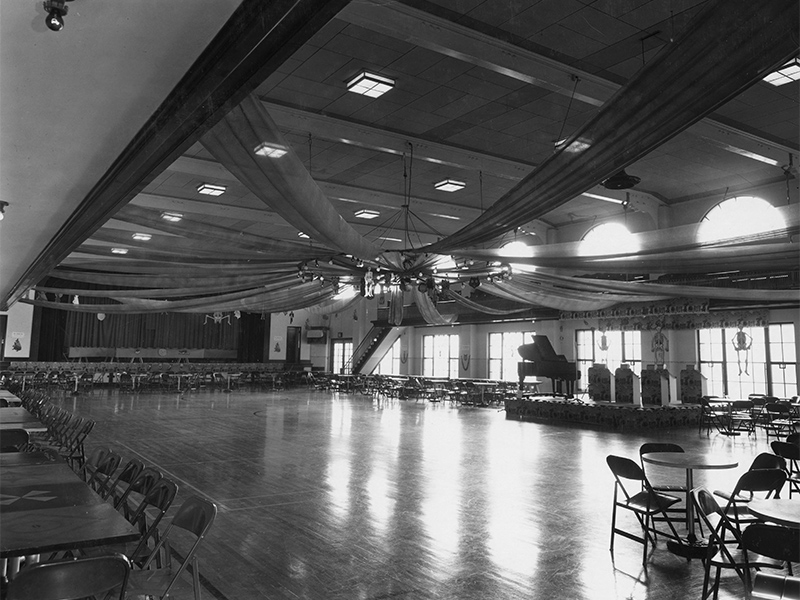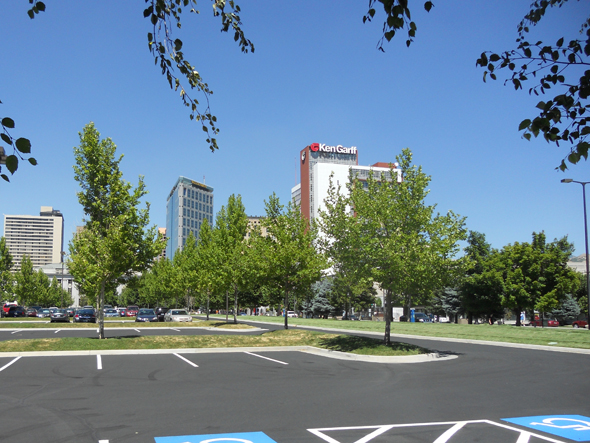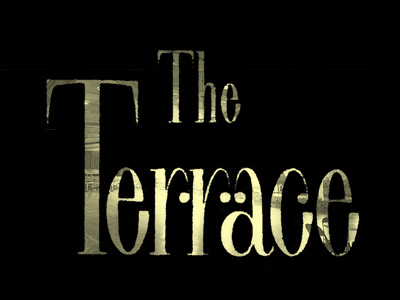
The history of The Terrace goes way back to 1922 in Salt Lake City. The building at 464 South Main was originally the Covey-Ballard Motor Company’s dealership. It wasn’t until 1931 that it became the popular dance hall known as the Coconut Grove which was advertised as the largest ballroom in America.

At some point, probably in the 1940s, the Coconut Grove became known as the Rainbow Ballroom. In 1946, the name changed again to the Rainbow Randevu when local musician Jerry Jones assumed ownership and began regular performances with his orchestra. The Randevu continued to feature a long list of top entertainers of the day. On 22 May 1948, the roof collapsed in a major fire, but damages were repaired within a matter of months.
Meanwhile in Farmington, Lagoon had been hosting popular musicians and performers at the Dancing Pavilion (and later the Patio Gardens) for most of its history. Lagoon became a favorite venue of bands who performed there and many of them returned several times. Perhaps because of this success the management at Lagoon felt they could handle a second venue.

The group took over the lease of the Rainbow Randevu at the end of 1958. It was renamed Danceland for a short time before they changed the name once again.

A $150,000 renovation of the building was completed in September 1959 when it reopened as The Terrace Ballroom. The name was derived from the new atmosphere of the venue which would include an opened up room to the south overlooking the dance floor.
A new, taller sign was added on the front of the building and the ticket window was removed. The entrance ramp was re-tilted to reduce noise and a new ticket window and aviary were built at the top of the ramp. In the lobby, fountains were added along with new check rooms. In the main auditorium, the dance floor was reconditioned and cedar paneling installed on the walls. Design consultants V. Douglas and Jinny Lee Snow took inspiration from different dance halls around the world.
The intention was to schedule the kind of top performers that Lagoon had become known for, during the winter months. There would also be weekly dances – the Max Engman Orchestra every Tuesday, a teen hop every Friday and Mel Hall and his Orchestra every Saturday. The auditorium had a capacity of 4,000 people and was made available for conventions, banquets and other events when not in use for dances or concerts.

Through the ’60s, the names on the marquee displayed musicians ranging from Martin Denny, Helen Forrest, the Beach Boys and the Four Freshmen to bands like The Who, Jefferson Airplane, Steppenwolf and Led Zeppelin (who actually opened for Vanilla Fudge). This transition brought with it different audiences and – to the apparent dismay of the management – an audience that seemed to have an increasing disregard for the law. A big chunk of the ballroom’s revenue was going towards repairs to damaged property and hiring extra officers to maintain order. Several attempts were made for cooperation from the younger crowds. Even though the problems were caused by “a sizable minority” as manager Boyd Jensen acknowledged, the decision was made to end rock concerts at The Terrace. Similar actions were being taken by venue owners around the country as well as Lagoon where the same decision was made two years earlier. The Terrace continued to have “non-rock, traditional musical dancing” twice a week and after a few trial runs, rock bands were allowed to perform at the ballroom again starting in 1972.
At least toward the end of its existence, The Terrace was actually being leased from Little America Company. This lease ran out in 1978 and Little America owners were thinking of using the property for either a new high-rise or a parking lot.
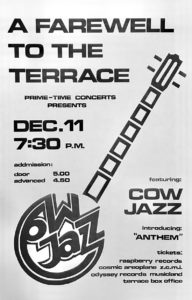
Founder of Prime-Time Concerts, Ray Cannefax, decided a farewell concert would be a fitting tribute to what had become a favorite venue to so many people. Reflecting on the concert he organized, Cannefax later said, “I think I lost money on that event, but someone had to do it and I never had a regret.”
Headlining the show was a popular band Cow Jazz from Park City along with the band Anthem. Later they were able to bring in Claudia Appling of Montana Rose. During her set, she sang Joni Mitchell’s “Big Yellow Taxi”, with the line that foreshadowed the eventual fate of The Terrace:
“they paved paradise and put up a parking lot.”

Terrace management looked at the possibility of relocating to Prudential Federal Corner at 3300 South State, but before anything was set into motion, Little America reconsidered their plans and allowed the lease to be renewed for three more years.
Many more concerts were held during that name including bands like Steppenwolf, Journey and The Police.
The Terrace closed for good after a New Year’s Eve party at the end of 1981 and sat empty until it was finally demolished. The Max Engman Orchestra had been playing for dances every Tuesday night for about 40 years. Lagoon Corp. continued to sponsor dances with the regular orchestra after the closure of The Terrace, but moved the location to the Salt Palace. Attendance decreased significantly and the tradition ended a few months later.
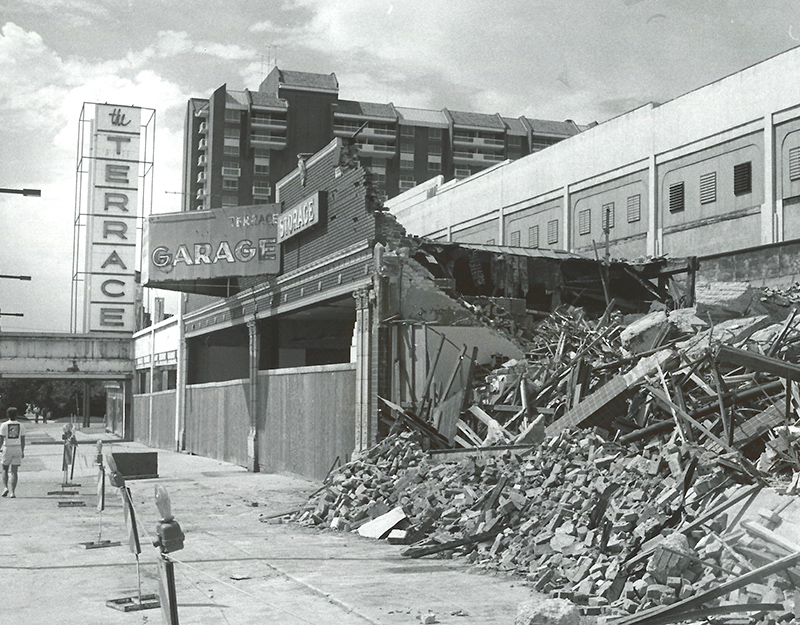
In August 1987, a fire broke out during demolition of the Terrace and burned much of what remained. The entire block was turned into a parking lot for Little America hotel patrons and was recently sold to The Church Of Jesus Christ Of Latter-Day Saints.
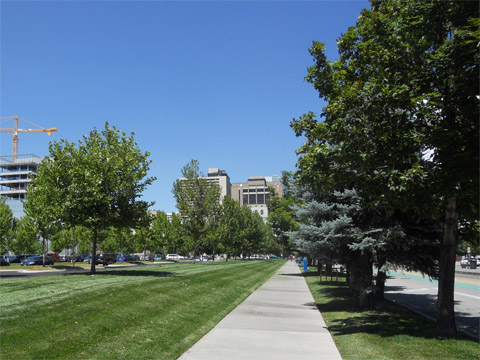
Throughout its history, the ballroom was home not only to concerts, but also political conventions, inaugural balls, school proms, church dances and many other events. Many people share fond memories of frequent visits to The Terrace and its earlier incarnations.
I have compiled alphabetical and chronological lists of performances at The Terrace from newspaper ads and from people who attended the shows. This list is far from complete. If you can confirm any additions or corrections to the lists, please contact me.

LIST OF PERFORMERS AT THE TERRACE

GALLERY

MORE FROM LHP

SOURCES
Cigaret Blamed For $175,000 Night Spot Fire. Salt Lake Tribune, 23 May 1948.
Danceland Sets Cole. Deseret News, 12 Feb 1959.
Remodeled Rainbow To Reopen As Terrace. Deseret News, 2 Sep 1959.
New Look For The Terrace. Deseret News, 7 Oct 1970.
Wickelhaus, Martha. Terrace to close doors after long, landmark life as SLC’s dance king. The Daily Utah Chronicle, 7 Dec 1978.
Terrace Ballroom reprieved. Deseret News, 28 Dec 1978.
An era ends as S.L.’s premier dance hall closes. Deseret News, 26 Dec 1981.
Terrace folds up the dance. Deseret News, 27 Apr 1982.
Flames become last dancers at the Terrace. Deseret News, 6 Aug 1987.
Meehan, Jay. CowJazz reunion. Park Record, 1 Oct 2013.
RE: Little America Other Comment. E-mail message to author. 24 May 2010.
Emails from Ray C. to author, Apr-Jul 2018.



